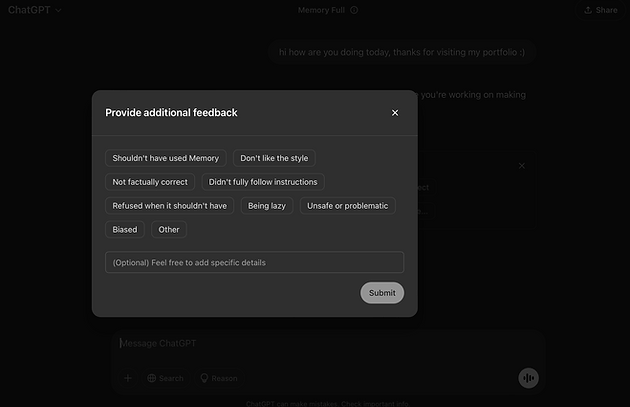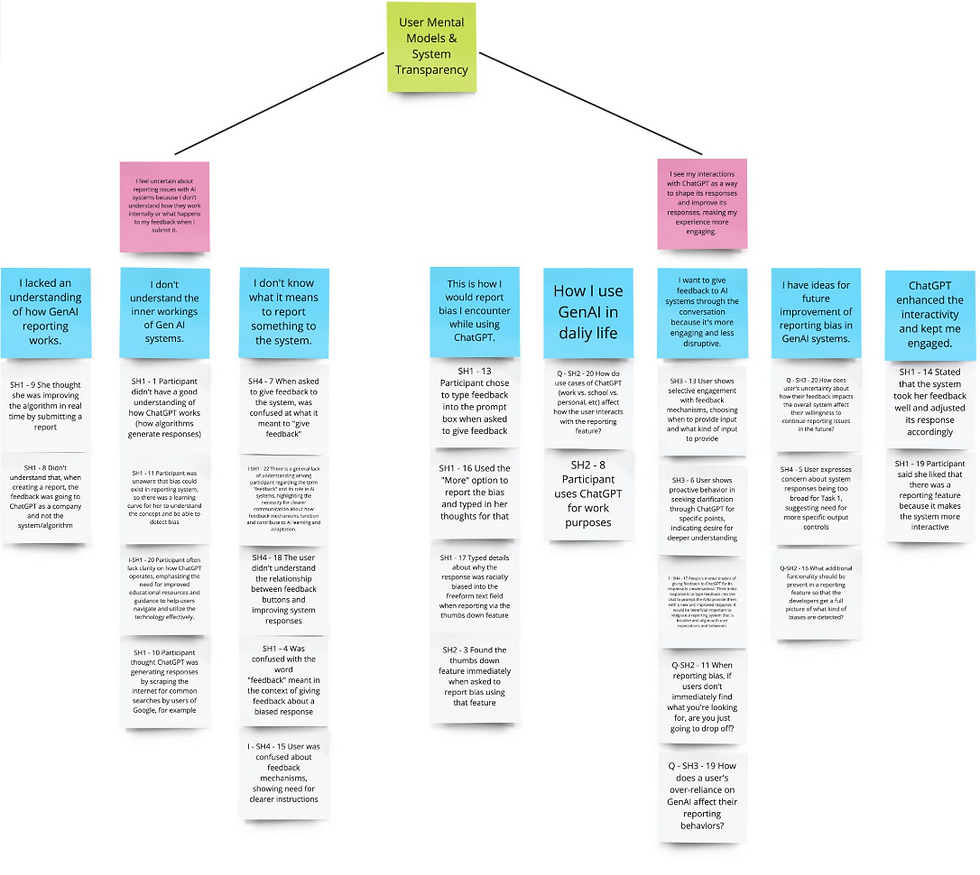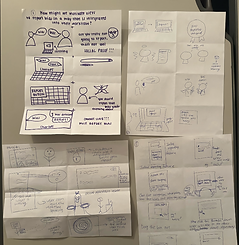Biased AI outputs stay in the system because reporting them is harder than ignoring them.
Introducing SPOTLIGHT

This project is not affiliated with OpenAI or ChatGPT
Role
Lead Researcher
Timeline
August 2024 - December 2024
Skills
User Research & Interviews
Usability Testing
Storyboarding/Speed-Dating
Think-aloud Testing
Paper Prototyping
UX Design
Team
Project Manager
Lead Researcher
UX Designer
Visual/Graphic Designer
THE RESEARCH TLDR
SUMMARY
I led a team of four researchers through qualitative user research to understand why users weren't reporting bias in AI systems, uncovering that workflow friction - not lack of motivation - was the primary barrier.
METHODS USED
Usability testing, think-aloud testing, behavioral analysis, prototype validation
KEY METRICS
-
40% improvement in bias reporting participation rates
-
Reduced reporting flow from 7 steps to 3 actions
-
SUS score of 81.9 (above "good" usability threshold, originally 62)
MY ROLE & RESEARCH IMPACT ON DESIGN
Led end-to-end research strategy and execution. Identified critical user behavior patterns that contradicted initial assumptions, enabling the design team to pivot from disruptive reporting flows to seamless workflow integration. My research directly shaped product direction and validated a scalable solution for AI bias collection.
PERCEIVED IMPACT TO CHATGPT
Research shows that making bias reporting feel natural instead of like a chore could significantly increase user participation and improve AI training data.
DEFINING THE PROBLEM
THE GOAL
As AI systems become more integrated into our daily lives, the ability to report bias becomes increasingly crucial. I led a team of 4 researchers to understand why users weren't reporting bias in generative AI systems.
Perception
If users cared about bias, they would report it
Discovery
The system itself was creating barriers to reporting
FINDING A FOCUS
Reverse Assumptions Activity
Our team began by listing out common assumptions about reporting in GenAI systems. Then, we flipped each assumption to challenge our thinking and uncover new perspectives.
This reverse assumptions activity revealed an opportunity we hadn't considered: could autofill technology make the reporting process less cumbersome?

INITIAL FOCUS
How might we leverage autofill technology to create a frictionless bias reporting process in GenAI systems?
PROJECT SCOPE
We narrowed our focus to ChatGPT's interface and workflow, testing with users who regularly use the platform.
ASSESSING THE CURRENT SYSTEM
TESTING WITH USERS
Think-aloud Sessions with 12 AI-users
I chose think-aloud testing because I suspected users weren't consciously aware of their reporting barriers. Watching them interact with ChatGPT's current system revealed something unexpected - they were naturally highlighting problematic text but had no idea this could connect to bias reporting. This observation shifted our entire approach from 'how to motivate reporting' to 'how to connect existing behaviors to reporting.
Most users see these as like/dislike buttons, missing their potential for reporting bias
Only after clicking thumbs down does the reporting option appear - a flow many users never discover

Critical bias reporting features hidden in a generic feedback flow


AFFINITY CLUSTERING




Unclear system processes
Difficulty recognizing bias
Lack of trust in the effectiveness of reporting
Affinity clustering revealed three barriers:
1
2
3
TASK FLOW DIAGRAM
Submitting a Bias Report

This task flow visualization showed the unnecessary complexity in the current reporting journey and the key drop-off points where users abandoned the process.
CONCEPT EXPLORATION
RAPID IDEATION
Crazy 8s Activity
We conducted a Crazy 8s exercise to rapidly generate solutions emerging from our research.




RAPID IDEATION
Storyboarding
From our crazy 8s exploration, we identified four essential user needs. To visualize potential solutions, we created storyboards for each need - exploring safe, risky, and riskiest approaches.
1
To be able to report bias in a way that does not interrupt their workflow.
2
Users need to understand how Chat GPT generates its responses.
3
Users need to be engaged for reporting bias.
4
Users need to know where and how to submit a report when using ChatGPT.

Example of 'riskiest approach' for need #4
DESIGN OPPORTUNITIES
User Testing
The storyboard testing uncovered potential areas for solution development.
Reduce Cognitive Load
Cut reporting friction by auto-populating forms and nudging users when bias appears
Increase Social Proof
Make reporting feel valuable by showing how it contributes to better AI for all users
Integrate into Workflow
Let users flag issues through conversation instead of hunting for separate reporting buttons
Make Reporting Flexible
Support both quick flags and detailed reports to match users' varying time and energy levels
REFINED FOCUS
How might we seamlessly integrate reporting into the user's workflow, enabling them to report bias quickly, efficiently, and with a clear understanding of how their input will impact the system?
USABILITY TESTING
CREATING AN ARTIFACT
Paper Prototyping
We built a paper prototype to test our ideas in the real world. This approach let us see how users actually interacted with our reporting flow before committing to high-fidelity designs.


DESIGN BREAKTHROUGH
Text Highlighting → Contextual Reporting
1
2
3
We observed users naturally highlighting problematic text in ChatGPT responses. Instead of creating a separate reporting flow, we attached reporting options directly to this existing behavior.
When users highlight text, a small contextual menu appears with bias reporting options - turning an instinctive action into a reporting opportunity.
This approach eliminated the awkward "switching tasks" feeling that users complained about with traditional reporting systems.
VALIDATION THROUGH TESTING
Our paper prototype testing had very positive feedback, with users quickly adopting the highlighting-to-report interaction pattern.
The prototype received an SUS score of 81.9 (above the 68 threshold for "good" usability), reflecting the intuitive nature of the design.
"Nice, it's super quick. Not having to stop everything I'm doing and go somewhere else."
"I'd totally find this by accident just highlighting stuff. Like, it's right there where you're already working."
THE SOLUTION
Spotlight: A text-highlighting system for seamless bias reporting in ChatGPT.



My Research Diary

Taking a research-first approach uncovered opportunities a design-only process might have missed. By studying how users actually behave, rather than jumping to interface solutions, we discovered how to integrate into their natural workflow.
REFLECTING
WHAT I LEARNED
This project challenged my assumptions about user behavior and research methodology. What began as a straightforward bias reporting task evolved into a deeper exploration of how people naturally interact with AI.
My role as a researcher has expanded beyond just gathering data. I've learned to synthesize seemingly unrelated observations into meaningful patterns that drive design decisions.
I learned to trust unconventional research methods. The reverse assumptions activity felt uncomfortable at first, but taught me that disrupting my own thinking often leads to breakthrough insights.
I now feel confident challenging team assumptions with evidence rather than opinions. This project helped me find my voice as a researcher and advocate for what users actually need rather than what we think they want.